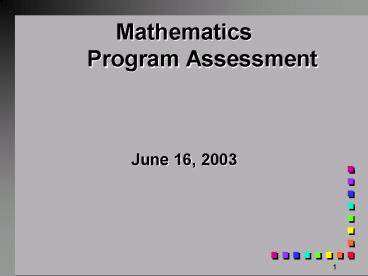Mathematics Program Assessment - PowerPoint PPT Presentation
1 / 34
Title:
Mathematics Program Assessment
Description:
Beth Dalzell. Angelo DeMattia. Mary Garrigan DeSarno. Roy ... Beatrix Ospina-Smith. Beverly Pilchman. Christopher Preston. Shelley Slafkes. Peter Trebour ... – PowerPoint PPT presentation
Number of Views:79
Avg rating:3.0/5.0
Title: Mathematics Program Assessment
1
Mathematics Program Assessment
- June 16, 2003
2
Committee Members
- Carol Barry Austin
- Patricia Barker
- Ellen Basile
- Kimberly Beane
- Candice Beattys
- Eugene Brown
- Juliette Campasano
- Jerry Clifford
3
Committee Members
- Beth Dalzell
- Angelo DeMattia
- Mary Garrigan DeSarno
- Roy Eismann
- Yolande Fleming
- Kathy Lamkin
- Deborah Marr
- Jim Memoli
4
Committee Members
- Nancy Murray
- Beatrix Ospina-Smith
- Beverly Pilchman
- Christopher Preston
- Shelley Slafkes
- Peter Trebour
- Fran Varon
5
Mission Statement
- The primary purpose of the Mathematics Program
is to enable all students to acquire the
mathematical skills, understandings, and
attitudes that they will need to be successful in
their careers and daily lives.
6
Primary Program Goals
- Students will
- Become mathematical problem solvers
- Learn to communicate mathematically
- Learn to reason mathematically
- Learn to value mathematics
- Become confident in their own ability
7
Secondary Program Goals
- Learning Environment Goals
- Equity and Excellence Goals
- Instructional Goals
- Curricular Goals
8
Progress Since the Last Program Assessment (1998)
- Tools of Change
- Curriculum
- Professional Development
- Assessment
9
Program Structure/MaterialsKindergarten - Grade 5
- Kindergarten- 30 minutes per day
- Trailblazers
- Manipulatives
- Grades 1-5 - 50-60 minutes per day
- Everyday Mathematics
- Supplementary Materials
- Manipulatives
- Calculators
10
Program Structure/MaterialsGrades 6-8
- Grades 6-8 - 240 minutes per week
- Middle School Math (grades 6-7)
- Math in Context (grades 6-7)
- Discovering Algebra (grade 8)
- Supplementary Materials
- Scientific and Graphing Calculators
- Computer Tools
- Manipulative Tools
11
Program Structure/MaterialsGrades 9-12
- Grade 9-12 - 200 minutes per week
- Tools for a Changing World (grade 9)
- University of Chicago School Mathematics Project
(grades 10,11,12) - McDougal-Little/Houghton Mifflin (grades 10-12)
- Scientific and Graphing Calculators
- Computer Tools
- Supplementary Materials
- Advanced Placement/Electives (grades 10-12)
12
Methods of Assessment and Results
- Grade 1 Criterion Referenced Test
- Assesses Six Content Clusters
- Proportionally weighted according to importance
of content
13
Methods of Assessment and Results
- On the Grade 1 Criterion Referenced Test,
students show satisfactory performance in the
data analysis, patterns, and measurement
clusters, with fewer students attaining mastery
in computation and geometry. - In number concepts, 95-100 of first graders
show strength in recognizing everyday use of
number, 50-75 evidence mastery of comparing and
ordering whole numbers, and 80-90 evidence
mastery of fractions.
14
Methods of Assessment and Results
- The Grades 2-7 Terra Nova NCE Trend Averages
indicate scores have remained relatively
consistent with significant growth at particular
grade levels. - Year Gr. 2 Gr. 3 Gr. 4 Gr. 5 Gr. 6
Gr.7 - 1999 63 68 64 64 63
- 2000 66 64 66 64
- 2001 61 68 64 65 65 65
- 2002 62 66 69 69 65 68
15
Methods of Assessment and Results
- 2002 Results
- Grade 4 ESPA
- 82 Proficient/Advanced Proficient
- Grade 8 GEPA
- 75 Proficient/Advanced Proficient
- Grade 11 HSPA
- 89 Proficient/Advanced Proficient
16
Methods of Assessment and Results
- Grades 1-7 Project Ahead
- 2000-2001 Cohort
- 65 exit after two years in Project Ahead
- Students who have four hours weekly of Project
Ahead Mathematics at the middle school level do
significantly better than those students who have
two hours weekly of Project Ahead Mathematics.
17
Methods of Assessment and Results
- State Tests Disaggregated Scores
- The scores on the three State assessments (ESPA,
GEPA, HSPA) indicate an achievement gap among
some of the categories specified by No Child Left
Behind.
18
Methods of Assessment and Results
- The percent of students taking calculus at
Columbia High School has increased from a
relatively constant rate of 13 to over 18 in
2002-2003.
19
Methods of Assessment and Results
- SURVEYS
- Grades 2, 5, 8 Parents
- Grades K-12 Teachers
- Grades 5, 8, 11 Students
20
Parent SurveysGrades 2, 5, 8
21
Student Survey ResultsGrades 5, 6, 8, 11
22
Teacher Survey Grades K-5
23
Teacher Survey By School K-5
24
Teacher Survey Grades 6-8
25
Teacher SurveyGrades 9-12
26
Survey Discussion Points
- Student Communication
- Instructional Strategies
- Multiple Solutions to Problems
- Real World Connections
27
Recommendations
- Review existing and explore new strategies and
programs to address the achievement gap in
mathematics at both the elementary and secondary
levels.
28
Recommendations
- Develop additional ways to raise student
achievement in mathematics at all levels and
provide additional support to the lower achieving
students since, in todays world, it is important
that all students are able to think
mathematically.
29
Recommendations
- Reexamine Project Ahead services in grades
1-8, particularly the starting date of services,
the weekly time allocations, the method of
delivery, and class size issues.
30
Recommendations
- Realign the K-12 mathematics program with the
recently revised (July 2002) New Jersey Core
Curriculum Content Standards for Mathematics.
31
Recommendations
- Continue to develop grade level assessments that
measure a students proficiency with the
mathematics goals and learning objectives and are
based upon state and national standards.
32
Recommendations
- Provide greater professional development
opportunities for mathematics teachers, which
include working collaboratively by engaging in
such professional development activities as grade
level meetings, peer observations, and peer
mentoring.
33
Recommendations
- Improve communication with parents regarding the
mathematics program.
34
Mathematics Program Assessment
- June 16, 2003































